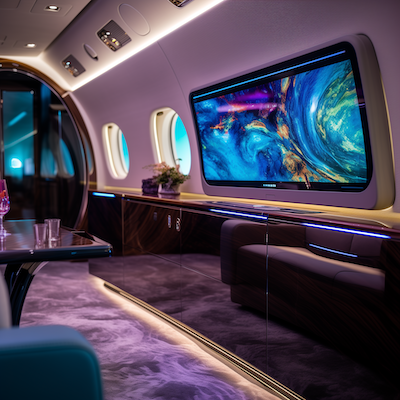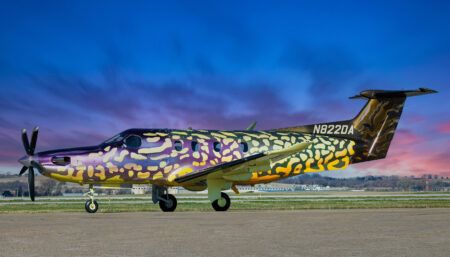Implementing artwork on private jets entails reaching a delicate balance between creative expression and rigorous aviation standards, finds Marisa Garcia.
Private jet owners seek to reflect their style in their cabins, and art is a popular channel for this. “All jet owners have an art collection, they are either art lovers or invest in art,” comments Matthieu Faëne, founder of Art&Jet, an art consultancy dedicated to private aviation.
David Vanderzwaag, CEO of Airhawke, which provides engineering and design services to completion centres, concurs that the demand is there: “It’s fairly common for us to get requests for paintings, as well as vases, lamps and clocks, all of which are intended to be an art statement.”
Temperature and pressure
Many technical challenges are involved in bringing art into private jets. Adam White, CEO, Comlux Completion, says the extreme environmental challenges that artworks face on aircraft, including fluctuating temperatures and pressures, necessitate carefully selecting artworks and materials. “These extreme temperature changes (from 115°F to sub-zero) can be detrimental to the art piece,” he explains. “In actuality, classic pieces of art should not be permanently installed in an aircraft.”
Reproductions of pieces from private collections can serve as an alternative. “It’s actually not uncommon for our clients to have custom artwork,” White adds.
Joerg Loewes, head of product sales completions and design at Lufthansa Technik, has seen a broad spectrum of requests for art installations on private jets, everything from “classic” paintings to photographs, sculptures and digital art. Metal or glass sculptures, unique glass bowls or sculpted lamps are common requests. Lufthansa Technik has also installed distinctive charred/carbonised pieces of withered wood crafted into an art exhibit. Plated metal engravings of various motifs or texts are more frequent, from famous quotes to verses to city skylines or other landmarks. In some cases, these metal inlays can also have a slightly three-dimensional appearance.
“A more recent trend involves NFTs [non-fungible tokens], digital art pieces that use crypto- and blockchain technology to certify their ownership and authenticity,” says Loewes. “These can be presented via digital screens or even the giant ceiling projection system presented with our Explorer VIP cabin concept, which uses projection technology by German company Diehl. Tailor-made NFTs of various styles and dimensions can also be a unique eye-catcher in the cabin of a VIP aircraft.”

Art&Jet also sees potential in digital art to be displayed on installed screens. The company is exploring an art subscription programme allowing aircraft owners to select from a catalogue of artists. “New artworks can be displayed every few weeks,” says Faëne of Art&Jet.
Safety first
Certification is a vital consideration for installed art. “Art must adhere to the same strict certification criteria as any other cabin monument or material installation,” says Loewes of Lufthansa Technik. “Adherence must be tested and documented for the certification process. Besides the requirements for flammability, smoke emissions or heat release, art pieces must safely withstand the mandatory 9g crash test.”
“Ensuring that installed art meets the airworthiness requirements typically involves modifying the art in some manner while also striving to ensure that the visual appeal of the item is maintained,” says Vanderzwaag of Airhawke. “This involves reprints on flam-safe materials; careful design and integration of mounting points; or, in some cases, creating a replica that is shatter-resistant or reinforced to maintain its structural integrity in the event of a crash landing. In one case, we reprinted an oil painting on silkscreen to the owner’s satisfaction and in duplicate to facilitate flammability testing.”
Installation approaches
Lufthansa Technik’s Loewes gives the example of a large metal statue of a prancing racing horse standing on its rear legs. “With only a minimal material connection (the two legs) to the ground support plate, it posed an enormous engineering task regarding the 9g certification,” he says.
Engineers addressed this with special restraints. “A steel mesh was invisibly routed through the horse’s legs into specifically engineered fixation points in the underlying piece of furniture and finally to the structural hardpoints and seat tracks,” Loewes says.
For another bronze animal statue, the furniture underneath was reinforced to support three to four times its normal point loads. Fixed glass elements have proved challenging to certify in the past. However, Loewes says that multi-layer glass has advanced enough to fulfil many requests in this area.
Location is critical
“The respective position/placement in the aircraft cabin is also of utmost importance for the certification, especially concerning evacuation scenarios and pathways,” Loewes says. “Paintings or photographs on the wall are usually not critical in this regard. Extensive sculptures, on the other hand, do have the potential to block an evacuation route or other vital safety features and hence have to be thoroughly engineered and certified. Weight and balance on the overall aircraft level is another essential aspect for cabin installations, but concentrated loads and the respective load paths are critical.”
Material choices
Materials are chosen carefully. “To mitigate flammability risks, we opt for materials like silk, wool and precious metals when commissioning artworks,” says David Knowles, CEO and founder of art consultancy Artelier. “To combat toxicity, we select paints that emit minimal harmful fumes, like watercolours or specialised acrylics. If weight is an issue, we prioritise lightweight solutions by incorporating materials like carbon fibre honeycomb and certified polycarbonate materials. To guarantee the artwork’s robustness we opt for bronze, steel and aluminium. The ‘Grab Test’ assesses whether you need to clutch onto an object during turbulence, and steel and bronze are preferred due to their durability, as they are less likely to break.”
Loose equipment
Another alternative, suggested by Knowles of Artelier and Loewes of Lufthansa Technik, is to add art as non-integrated or ‘loose’ items, categorised as carry-ons. These must be safely stowed and latched during taxi, takeoff and landing. “There are very few off-limit ideas for art in private aircraft,” says Loewes. “Our engineers have decades of experience that helps realise most demanding requests. Only in some cases – for example where the aircraft is chartered, and thus the stricter commercial certification rules apply– might some ideas have to be rethought or rejected.”
“Nothing is strictly off-limit,” says Artelier’s Knowles. “Our job is to turn clients’ ambitions into tangible realities. The option to have carry-on artwork means that clients can have anything they want within reason. That said, we will avoid oil paint, combustible materials, or delicate materials like ceramics, porcelain or glass.”
This feature was written by Marisa Garcia and first published in the March/April 2024 edition of Business Jet Interiors International. Click here to read the full feature.





